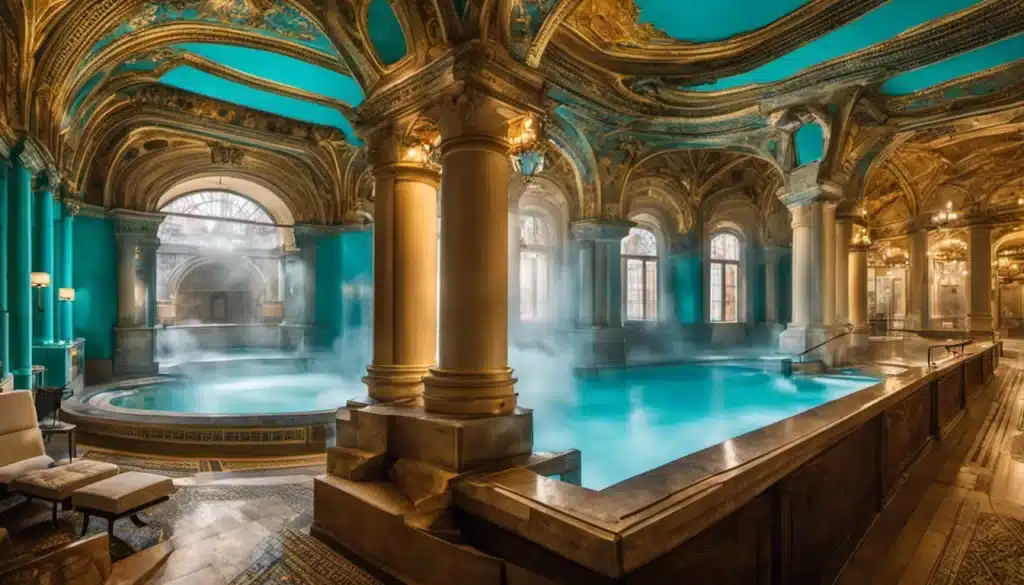Hungary boasts more than 1,300 thermal springs, including 123 fonts in Budapest alone, earning it the nickname “City of Spas.” Many travelers need to remember this when visiting this beautiful city because it is worth visiting, especially during winter, spring, and autumn. In this article, we will discuss The Best Budapest Spa bathhouses. Let’s see what they are.
Our website includes affiliate links. So, remember that we may receive commissions when you click our links and make purchases. Please read our legal disclaimer document for more information about our Affiliate disclaimer and other disclaimers like the Fair-Use disclaimer.
Introduction to The Best Budapest Spa Bathhouses
Welcome to Budapest, the “World’s Spa Capital.” Nothing feels more relaxing in this captivating, cultured city than plunging into a thermal pool and soaking away your stress and worries in warm, muscle-melting, mineral-rich waters. Hungary rests upon an absolute bounty of geothermal, medicinal wonders. There are also many outstanding possibilities in the countryside, ranging from the famous medicinal pond of Héviz to the stinky, sulfuric splendor of the eastern provinces. That’s why Budapest is a heaven for those striving for relaxation, healing, and quirky local culture.
More significantly, these are not just any baths—they are architectural marvels, time portals, wellness havens, social hubs, and a crucial part of the Budapest experience. Budapest’s thermal baths bear the weight of centuries, each a testament to the city’s rich history and enduring culture. Whether you’re seeking treatment for your conditions or a taste of local life, here’s everything you need to know about Budapest’s thermal baths, a unique blend of history, culture, and relaxation.
Budapest bathing across the centuries
Firstly, Budapest alone produces some 40,000 square meters of warm, mineral-rich water daily. Before the Roman conquest, the area around present-day Budapest was inhabited by a Celtic tribe, the Eravisci, who named this land Ak-ink (Abundant Water).
Romans built the regional capital of Aquincum and quickly began taking advantage of Hungary’s thermal springs, as evidenced by the ruins of Roman bathhouses around the country’s borders. The most notable spa in Aquincum was the Thermae Maiores (Great Bath) near Flórián tér in Óbuda, which had luxuries such as hot and cold piped water and underfloor heating.
However, bathing only became integral to Hungary’s life during the 16th and 17th centuries of the Ottoman Occupation. The Ottomans built elegant hammam-style baths consisting of octagonal pools topped by high-domed ceilings dotted with glass inlays, allowing light rays to shine through and strike the water.
Two historic bathhouses – Rudas Baths and Veli Bej Baths – are still used today. Still, most of Budapest’s other historic baths, such as Széchenyi Baths or Gellért Baths, were built in the 19th and 20th centuries, during Budapest’s time as the second capital of the Austro-Hungarian Empire.
Note: If you are wondering what to do between bathing and later in the evening, we recommend watching Get Your Guide Tours.
The healing power of Budapest’s waters
Many Budapest bathhouses proudly glorify the healing properties of their waters. These warm, mineral-rich waters, bubbling up from underground caves, contain minerals like calcium, hydrogen carbonate, magnesium, sodium, sulfate, chlorides, and metaboric acid. A dip in these waters isn’t just a pampering experience; it’s a therapeutic journey that can help relieve several health problems, ranging from arthritis and muscle pain to slipped discs, circulatory disorders, nerve pain, respiratory illnesses, orthopedic issues, and hangovers.
Studies have shown that bathing in mineral-rich water can help relieve several health problems, ranging from arthritis and muscle pain to slipped discs, circulatory disorders, nerve pain, respiratory illnesses, orthopedic issues, and even hangovers—we’ve tried and tested this last one and can confirm that it helps!
The mineral-rich waters also benefit muscles and bones. Drinking the spa waters is said to boost your health from within, and locals swear by this. If you’d like to try this liquid treatment, visit the ivókút (drinking halls) of Széchenyi, Lukács, and Rudas Baths. All three sell potable spa water for a small price, though bringing your bottle is best.
What to bring: Essentials for the Budapest bathhouse experience
Pack swimwear, a towel, and flip-flops; the floor can be slippery. Swimming caps must be worn in the lap pools. Bathing accessories are available to rent or buy, but bringing your own is better and cheaper. Showers and hair dryers are available, so bring soap, shampoo, and other personal cleaning products.
Upon arrival at a bathhouse, you’ll receive an electronic bracelet and a convenient key to your locker or cabin—a more private but slightly pricier changing space. You can choose any available locker, and attendants can always assist. If you plan to use the outdoor pools at Széchenyi, smaller poolside lockers are available for your wallet or phone.
What is the etiquette of the Budapest spa bathhouses?
Before jumping into the warm waters, shower and tie your long hair back to avoid being told off by attendants. Secondly, keep the noise minimal. Remember also that the baths are not the same as lidos and waterparks—some people are here to heal, so anything more than quiet chatting is frowned upon. However, outdoor pools with waves and whirlpools differ, and a more relaxed mood prevails.
More importantly, avoid soaking in the warm waters for too long, as you might get lightheaded. Signs by the pools specify the water temperature and may advise how much time to spend inside—generally 20 minutes. Remember to stay hydrated; drinking fountains are available at most baths, but note that eating and drinking are not allowed in the pools.
Budapest is a dynamic, modern city, but some timeless customs help preserve a long-standing cultural history—such as the traditions at the thermal baths. Knowing your bath etiquette will give you a more relaxing and authentic experience and help you get the most out of your visit.
- Bring your own towel and bathing suit. Look out for women-or men-only sessions where bathing suits are unnecessary, but remember that many are now coed, and bathing suits are compulsory.
- Two towels are often recommended: one to use throughout your spa day and one at the end. Towels and bathing suits are available for rental at most bath receptions, so don’t panic if you forget to pack the essentials.
- Swimming caps are always advised if you have long hair and want to swim in larger pools.
- Have a game of chess. At Széchenyi Baths, you will often find semi-submerged Hungarian bathers pondering over outdoor chess, contemplating their next move through the thermal steam.
- Enjoy natural healing. At Lukács, the drinking fountain has a long reputation for healing qualities and has been bottled and distributed worldwide for many years.
- Tickets can seem overwhelming as there are often many choices, but don’t be concerned if you get multiple tickets: they will be for swimming, a locker, and a cabin, and so on.
- The water and varying temperatures are famed for their healing qualities, and Hungarians enjoy the spa sessions for sports, health, and relaxation purposes. Indulge in some spa therapy and feel city stress drain away.
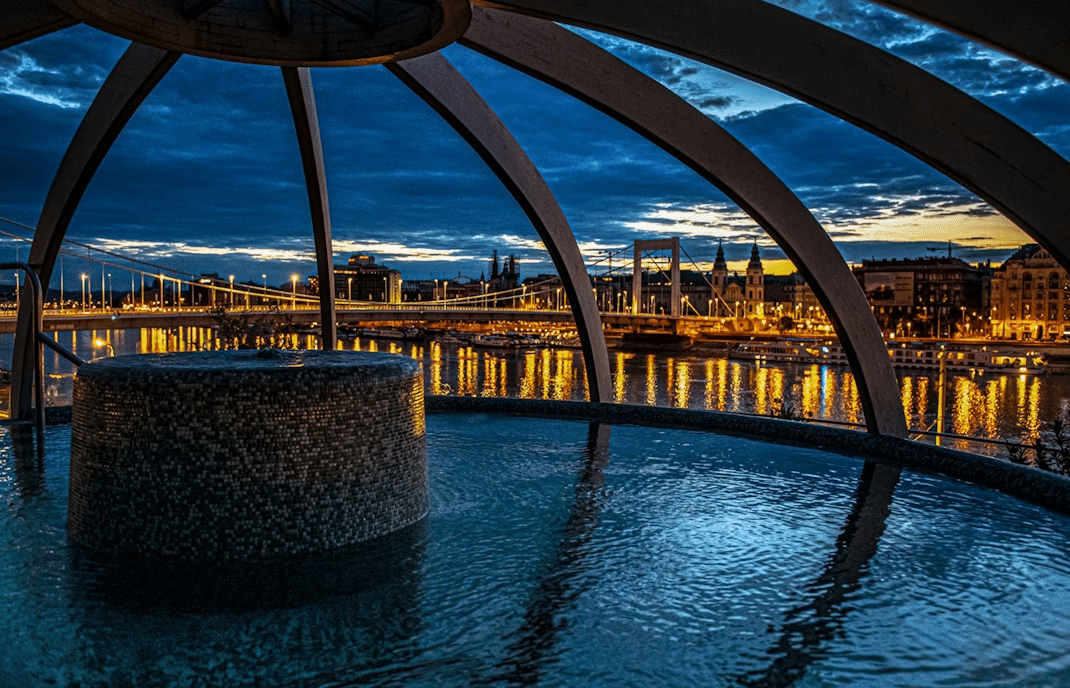
©Budapest.org
Which is the best Budapest Spa bathhouse, according to local opinion?
It is your choice which bath you visit, but the following are our favorites.
Rudas Thermal Bath – A Historic Ottoman-style Retreat
Since 1571, the Rudas Thermal Bath has been in Buda in the shadow of the majestic Buda Castle. It is one of Budapest’s four 16th-century Turkish baths, resplendent with decorative elements like Ottoman domes and an octagonal pool. Therefore, they represent an incredibly authentic experience. You’ve got these domed ceilings with excellent, colored glass. We love it because you feel so revitalized when you come out.
Furthermore, it would help if you visited them as early as possible before they get crowded. It’s about the minerals,” explained the local skincare specialists. They’re not necessarily bioavailable. When you get into these thermal baths , due to the heat and prolonged skin exposure, the minerals are absorbed, and the benefits are realized. When you get out, that water will evaporate, and the minerals will be drawn back to the skin’s surface.”
You can buy tickets by clicking here.
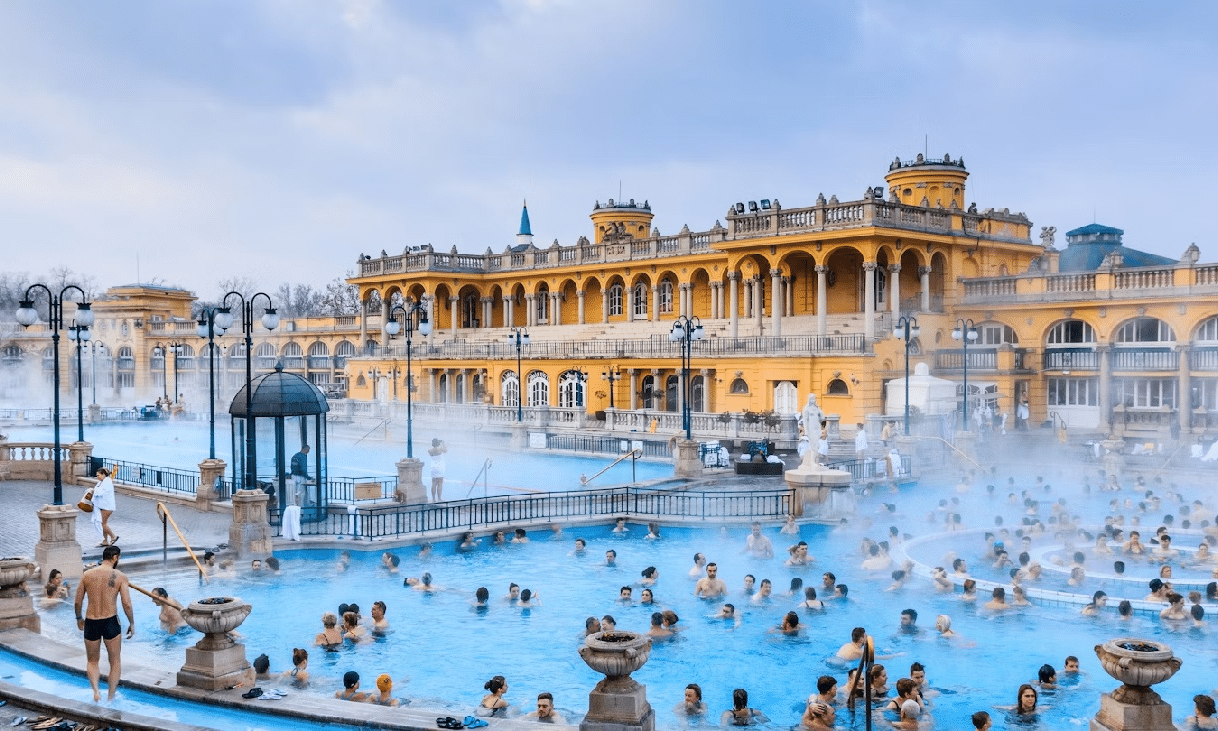
©Will Sanders / Lonely Planet
Széchenyi Thermal Bath -Europe’s Largest Medicinal Bath
Next in our list of the best Budapest Spa bathhouses are most likely the most famous ones. These thermal baths are pure joy – a sea of happy, healthy merfolk – and, according to locals, the best outdoor pool in Budapest, namely the Széchenyi Thermal Bath. It’s spectacular outside… especially in the winter when the steam rises. Furthermore, they have thermal baths of different temperatures. The hot spring temperatures range from a brisk 18C to a scalding 40C [104F].”
The Széchenyi Thermal Bath is located in Pest’s lush City Park and is one of the largest spa complexes in Europe, boasting a tremendous 18 thermal pools. It was built in 1881 in the Neo-Baroque style, and renowned Hungarian geothermal expert Vilmos Zsigmondy unleashed its thermal water source.
Note: You can buy tickets by clicking here; however, if you want to attend Sparty, you can purchase tickets using this link.

©gellertbath.hu
Gellért Thermal Bath – A Gem of Art Nouveau Architecture
The lavishly ornate Gellért Thermal Bath and Hotel in Buda is possibly the most famous of Budapest’s spas – and a renowned example of luxe Hungarian spa interiors.
Built between 1912 and 1918 in the Secession Art Nouveau style, the Gellért’s exquisitely tiled indoor and outdoor thermal pools, mosaic-covered arches, and majestic carved columns are undeniably jaw-dropping. When you tear yourself away from ogling the architecture, the spa offers a Finnish sauna and luxurious massage services. Guests can enjoy private bathing, medical services, and sauna access.
If you want to visit this magnificent bathhouse, you can buy tickets here.
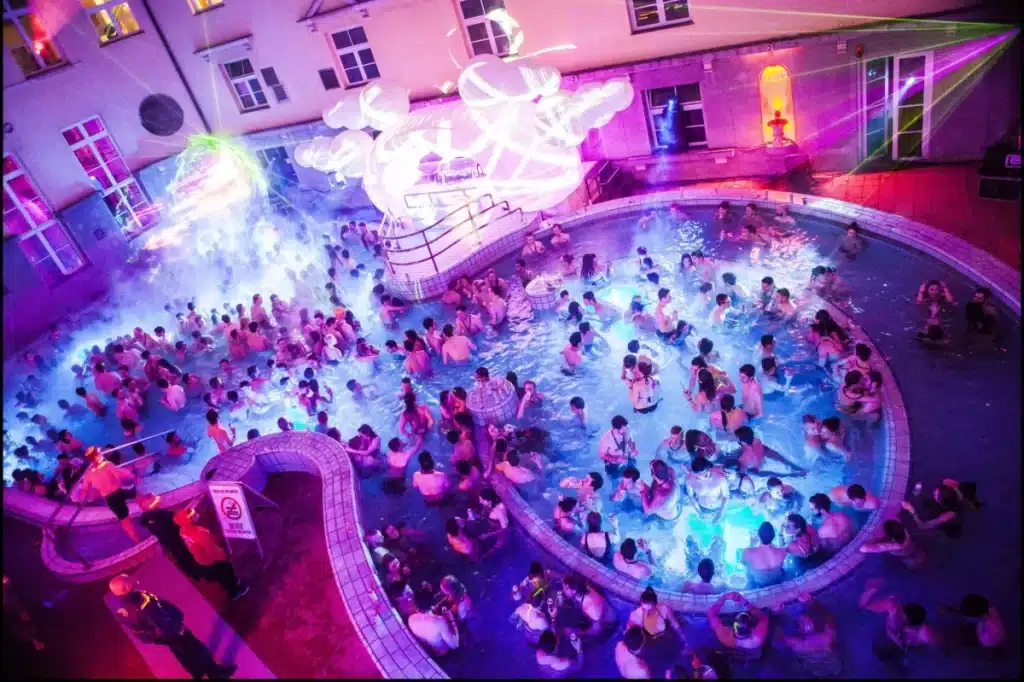
©budapest.yourcityvisit.com
Lukács Thermal Bath – Best for medicinal healing
As famous as Hungarian thermal spas are for relaxation, they’re more revered for their clinical treatments. Doctors prescribe trips to these thermal baths. If you have rosacea, psoriasis, or rheumatism, the more time you spend in these healing waters, the less time you’ll pay in the critical care units in hospitals. Budapest’s most famous medicinal thermal spa complex is the Lukács indoor and outdoor thermal bath, a few minutes walk from Margaret Bridge in Buda, near Margaret Island.
“It’s a beautiful 19th-century complex. In the 1970s, it became a water hospital for treating ailments. You can pay a little bit to drink the water.
Furthermore, the suggested drinkable water dose is 300-500ml per day, and it is said to help cure stomach issues like gastritis and kidney and respiratory disturbances. Medical treatment courses last 15 days and are only accessible with a doctor’s prescription.
If you want to visit this magnificent bathhouse, you can buy tickets here.
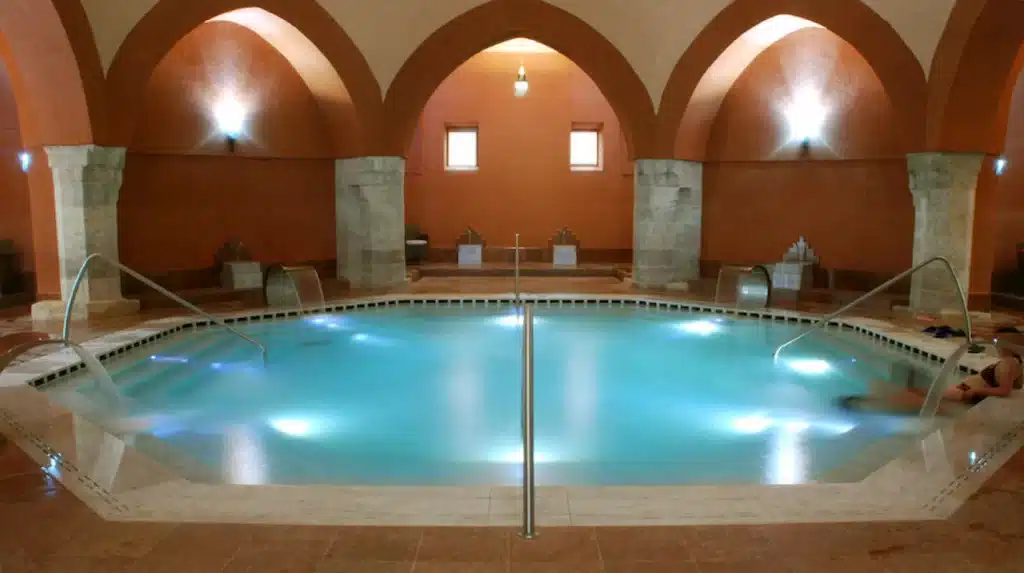
©csaszarhotel.hu/veli-bej-spa-budapest/#prettyPhoto
Veli Bej Baths – A Turkish Delight in Budapest
Part of a hospital complex near the Lukács Baths, the Veli Bej shares the same 16th-century Ottoman heritage as the Rudas and the long-closed Király on the Buda side. Only converted for contemporary public use in recent years, this smaller complex operates daily between 3 pm and 9 pm and 6 am and noon at weekends, and your ticket is valid for three hours. Original features like the stone arches and cupola remain from the Turkish era, while the sauna area feels neat and modern, equipped with an ice machine and showers.
Tip: If you have time to venture further, don’t miss our guide to The Best Spa Resorts in Hungary Beyond Budapest, which includes truly unique destinations like the Hévíz Thermal Lake Guide, where you can float among water lilies year-round.
Frequently Asked Questions
Are Budapest Spa Baths worth it?
Yes, it’s the most worthwhile tourist activity you can do. However, the value options on this list are significantly more valuable than the others.
How long do you need at the thermal baths in Budapest?
An average visit lasts 2 hours. Most passes last as long as you like, and many people camp out for the day. You can bring a book or three and some snacks and enjoy an extended session. The minimum is 90 minutes.
Do I need flip-flops for Budapest baths?
It is usually required, though little enforced. But ew. Come on, wear flip-flops for your own sake.
Do you wear clothes in Budapest baths?
Almost all of the bathing facilities at this point are coed, and bathing attire is required. Exceptions are the single-gendered times at Rudas, where a traditional loincloth is provided. These are usually in the morning hours during the week, but please check the schedule ahead of time, as it varies, and there is nothing worse than showing up for the wrong gendered session when you are ready to plop yourself into an Ottoman-era tub. There are also a few saunas around these various baths, which you will need to go in with only a textile.
What is the best time of day to visit the Széchenyi Baths?
If you come on a weekend, our tip is to visit Széchenyi at an off-peak hour, preferably in the early morning or on the odd Monday, Tuesday, or Wednesday evening.
Do you get a towel at Budapest Baths?
No. Please bring at least one of your own, but it’s better to get two for the saunas, where you can pat dry, lie down on, and dry off at the end of your session.
Can you take photos in the Budapest baths?
Mostly yes. But please be respectful of privacy and self-aware of the atmosphere. For example, guests at Széchenyi Bath expect tons of tourists to take photos, whereas, in some smaller and local places, you will get dirty looks. On a case-by-case basis, take one picture and enjoy the bath.
What should you bring to a thermal bath in Budapest?
You should bring at least two towels, a bathing suit, a change of clothes, a plastic bag (they usually have these or a centrifuge to dry stuff, but just in case), and your favorite book.
Take a look at
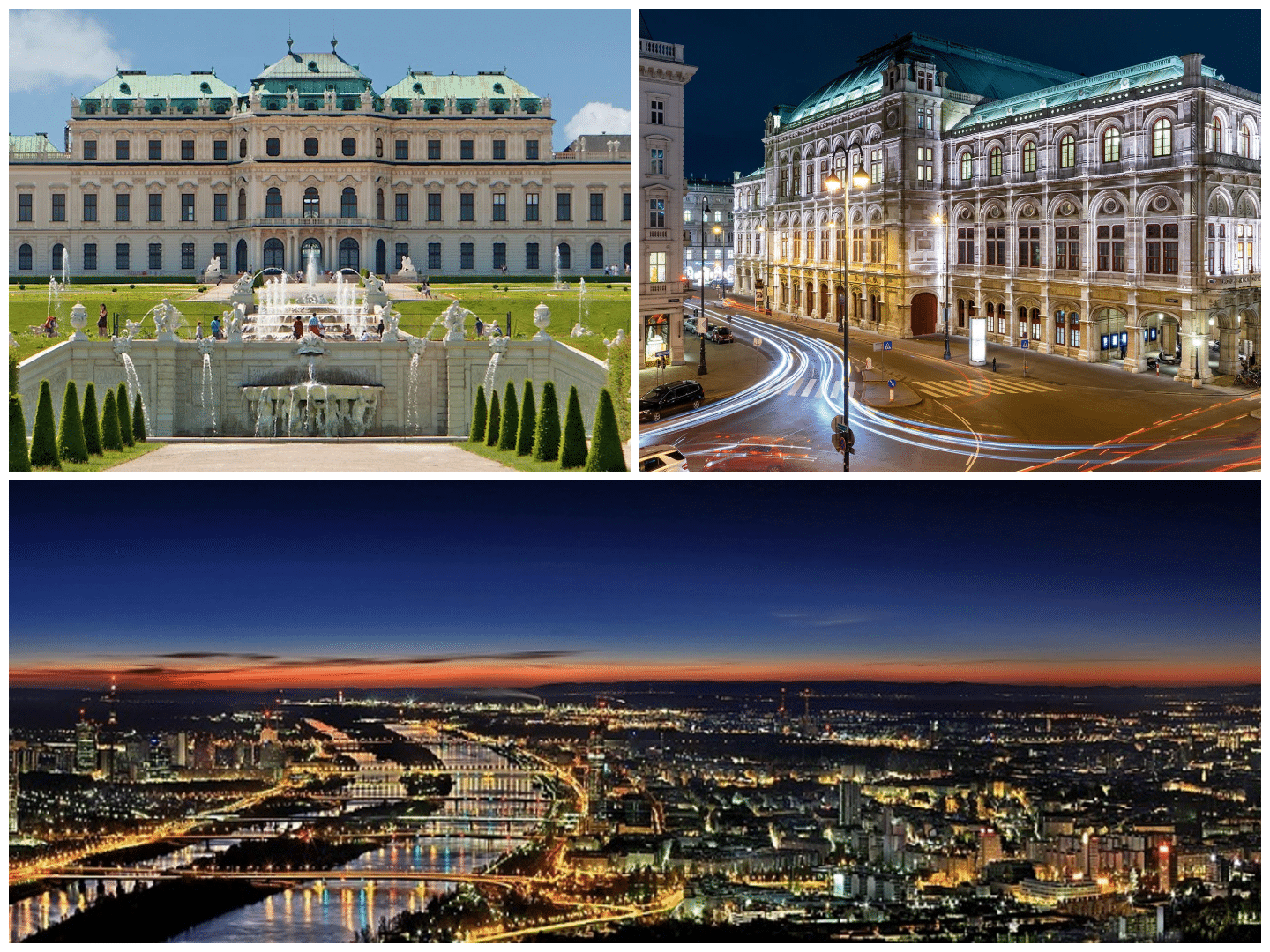
Our Vienna Guide
Have you ever wondered why you should visit Vienna, the Austrian capital, and what is so special about it? If
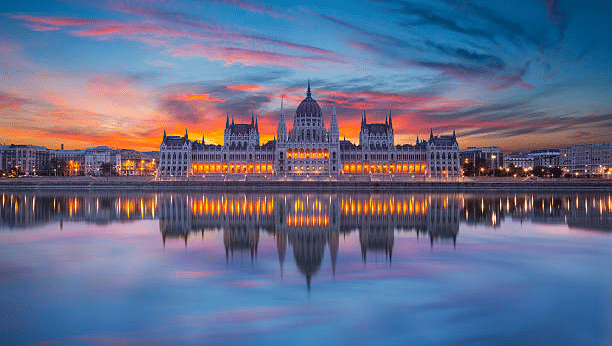
Budapest travel guide
This article, Budapest travel guide, will reveal to you the city’s most appealing attractions, advice, and other helpful information about

Discover the fantastic thermal spa resort Olimia
In this post, we will discover this fantastic thermal spa resort, Olimia, which has been the leading spa resort in
Photo credits:
Feature photo credits: Will Sanders / Lonely Planet

